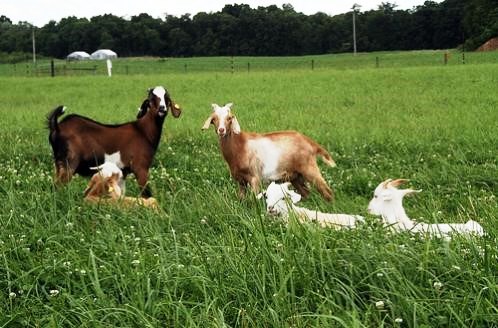Dr. Henry Grant, County Extension Director, Livestock Agent, Gadsden County Extension Service
A winter feeding program for meat goats should have as its main objectives: to provide the nutrients necessary to maintain a reasonable body condition, to prevent weight loss, and to maintain the necessary body heat to stay warm. Although extremely cold weather is not a factor in Florida, the basic wintering needs for meat goats must be provided. One of the major effects of cold weather on goats is an increased need for energy to stay warm. Energy to generate body heat comes from food or stored fat. Other livestock such as cattle and horses add layers of fat on their sides under their skin. These fat layers serve as body insulation in cold weather, and a source of stored energy. Goats, however, add fat to their internal organs first, before storing under their skin; therefore, they are vulnerable to cold weather and require protection from wind chill and cold rain. If feeding levels are not increased during periods of cold weather, goats will burn body fat and lose weight. If cold weather continues and the goat’s stored fat is used up, signs of hypothermia will appear as animals become weak, stop eating, and become depressed. During periods of severe or prolonged cold, goats must be kept warm and fed.
Good quality hay is the best way to increase body heat while maintaining a safe, more consistent energy intake. Forages and hay produce more heat than concentrate mixes. Concentrates contain more total digestible energy than hay, but the amount of actual heat given off by the digestion and fermentation of hay is considerably more.
Nutrition
The nutrients goats need are proteins, carbohydrates, fats, vitamins, minerals and water. Carbohydrates and fats provide energy. Protein is required by the body for muscle growth, milk production, disease resistance, reproduction, and body maintenance.
Goats, being natural browsers, thrive on a combination of year round grazing and preserved forages. As natural browsers, goats are able to survive under more harsh conditions than either sheep of cattle. Goats selectively use a wide variety of shrubs, woody plants, weeds and briars. This variety will provide very good nutrition for the meat goat during the wintering period. A wintering program should consist of forage and supplements. Forages are: hay, stockpiled grasses, or some by-product roughage feed. Some commonly used and inexpensive supplements are: shelled corn, which provide energy; range cubes, protein blocks, molasses blocks or tubs, and liquid feeds which provide protein and energy. Without sufficient energy, goat’s conception rates, milk flow, and kid growth rates will be compromised.
The single most significant cost in any livestock operation is feed. It averages 45% to 64% of the cost of production. To be economically viable, meat goats must get most of their required nutrients from forages. When available forage is inadequate to provide the protein, energy or minerals needed for the desired levels of goat performance, appropriate supplementation should be available, keeping in mind the cost benefit. Winter grazing of small grain pastures for 1-2 hours per day will provide adequate supplementation of protein and energy when using dry pastures or low quality hay. The continuous use of roughage (even poor quality) is important during this type of protein supplementation to economically allow the animal to assimilate the protein being supplied.
High protein supplement feedstuffs commonly used are cottonseed meal, soybean meal, whole cottonseed and gluten feeds. When declining pastures and browse reach an unacceptable low energy level, good quality hay, along with 0.5 -1.0 pound of shelled corn or cottonseed should be added to the feeding program.
Shelter and Water
Goats are vulnerable to cold, wet, weather and need access to shelter to protect them from wind chill and cold rain. Animals in general that are newborn, thin, stressed or sick are at risk in bad weather and need shelter. Underweight newborns, multiple births and pregnant does are more susceptible to herd losses during cold weather without good shelter.
Water supply is essential for livestock whether confined or pastured. The water intake of the goat may vary depending on the season of the year. More water is generally required during warmer times of the year. No matter the temperature, clean water should be available at all time. Goats will refuse to eat if adequate water is not available.
Meat goats provided with enough high quality feed, a clean water supply, and adequate shelter will winter well in north Florida.
Sources of Information:
Solaiman, S. G. (2008). Feeding Management of A Meat Goat Herd (Technical Paper No. 06-11). Tuskegee, AL, Tuskegee University.
Pinkerton, F. and Prinkerton, B., Feeding Program For Meat Goats, Meat Goat Production Handbook. Retrieved September 19, 2009, from http://www.smallstock.info/reference/meat-goat/handbook/feeding.html
Goat Winter Feeding of Does. eXtension. Retrieved September 19, 2009, from http://www.extension.org/pages/Goat_Winter_Feeding_of_Does
Parson, P., Back to Basics Winter Goat Management. Georgia Boers. Retrieved September 19, 2009, from http://www.boergoats.com/clean/articleads.php?art=490
Pinkerton, F. and Pinkerton, B. Supplemental Winter Feeding of Goats, Clemson University, South African Boar Goats. Retrieved September 21, 2009, from http://www.sa-boergoats.com/ASP/other/suppl-winter-feeding.asp
- May 2025 Weather Summary and Summer Outlook - June 20, 2025
- Friday Feature:The History of Angus Cattle - June 20, 2025
- Friday Feature:High Quality Legume Hay Production – Virtual Tour of Conrad Farms - June 6, 2025

